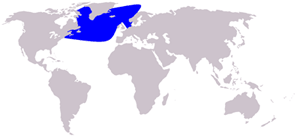 A Northern bottlenosed whale (Hyperoodon ampullatus) is swimming in the Thames. See the video here. Usually, whales don't swim up rivers except when they are sick. However, vet experts have said it doesn't seem to be ill. Rescuers in boats are trying to keep it away from the Thames's banks, on which it would likely strand when coming to close. Northern bottlenosed whales weigh around seven tonnes usually, so this will complicate things even more when trying to rescue the whale. There is just no way to gently guide it in a certain direction. If it wants to swim in another direction, it will. Other strange animals spotted in the Thames over the years include dolphins, porpoises and seals.
A Northern bottlenosed whale (Hyperoodon ampullatus) is swimming in the Thames. See the video here. Usually, whales don't swim up rivers except when they are sick. However, vet experts have said it doesn't seem to be ill. Rescuers in boats are trying to keep it away from the Thames's banks, on which it would likely strand when coming to close. Northern bottlenosed whales weigh around seven tonnes usually, so this will complicate things even more when trying to rescue the whale. There is just no way to gently guide it in a certain direction. If it wants to swim in another direction, it will. Other strange animals spotted in the Thames over the years include dolphins, porpoises and seals. Update: Unfortunately, despite rescue attempts the whale has died...

Range map of the Northern bottlenosed whale under GNU Free Documentation License
Resources:
Article on the bbc, including video
Wikipedia on the Northern bottlenosed whale
The Bottlehead, north atlantic bottlenose whale, northern bottlenose whale is listed as Conservation Dependent (LR/cd), the focus of a continuing taxon-specific or habitat-specific conservation programme targeted towards the taxon in question, the cessation of which would result in the taxon qualifying for one of the threatened categories below within a period of five years, on the IUCN Red List of Threatened Species
Namings for the northern bottlenose whale
A young / baby of a northern bottlenose whale is called a 'calf'. The females are called 'cow' and males 'bull'. A northern bottlenose whale group is called a 'gam, pod or herd'.Some facts about the
Northern bottlenose whale
Adult weight : 6500 kg (14300 lbs)
Maximum longevity : 37 years
Female maturity :3652 days
Male maturity : 3287 days
Gestation : 365 days
Weaning : 365 days
Litter size : 1
Litters per year : 1
Interval between litters : 365 days
